Attendees came from 17 countries in Europe, America and Asia with 22 participants alone from Japan. The 8th International Conference on Integrated Power Electronics Systems (CIPS 2014) was held on 25-27 February 2014 in Nuremberg. The Conference is organized by ETG, the Power Engineering Society within VDE, and by ECPE, the European Center of Power Electronics. IEEE PELS and ZVEI are technical co-sponsors.
The program of this year’s conference covers 80 papers: Three keynotes, 9 invited, 39 oral and 29 poster papers. A good balance of contributions was achieved: 21 were from industry, 20 from industry and academia, and 39 from academia and research institutes (e.g. 6 from Fraunhofer institutes).
Prof. Johann Kolar/ ETH Zurich explained in the 1st keynote speech his thoughts on “What are the big challenges and opportunities in power electronics”. Here a brief summary:
- Power semiconductors, gate drive, and packaging: Some major changes already happened like the introduction of GaN system integration and Ag sintering. In addition there is a continuous improvement in packaging concerning parasitic inductances, improved heat management and reliability. The main future challenges for module manufacturers are 3D electromagnetic “quiet” packages, integrated programmable gate drives and passive filter components and lifetime simulation and testing. General users will have to deal with a significantly higher level of integration (e.g. embedded integrated power boards) and with fundamental changes in design, manufacturing and measurement techniques.
- Magnetics and capacitors: generally only gradual improvements can be expected. For magnetic devices a careful design is absolutely mandatory which also includes an improved thermal management. In general high frequency operation will become more important due to the use of SiC and GaN power semiconductors.
- New topologies and modulation/control schemes: The basic concepts are known since several decades, but there are some exceptions like multi-cell converters and three-phase isolated AC/DC buck converters. The message is – go with the most basic structures and avoid to integrate several functions. This keeps degrees of freedom for the design and control and will help to ensure low costs and to increase reliability.
- Virtual prototyping: this remains most challenging regarding modeling and simulation of EMI and reliability. More work is needed especially for model order reduction and multi-stress analysis and testing.
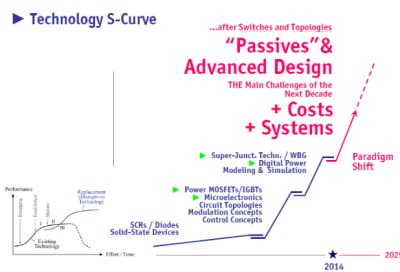 Zoom Picture
Zoom Picture
Figure 1: Prof. Johann Kolar’s view into the future for which he expects paradigm shifts
Figure 1 shows his summary which means a shift of paradigm from the focus on switches and topologies towards passives and future smart distribution systems where not “Power Conversion” but “Energy Management”, not “Converter Analysis” but “Converter – Source or Load Interaction Analysis”, and not “Converter Stability” but the “Stability of Converter Systems / Clusters” will be most important. Of course lower costs for converters and systems will be of paramount importance as well.
In the second keynote speech Prof. Abhijit DasGupta/ CALCE, University of Maryland – one of the pioneers of the Physics of Failure approach – reported on his studies to excite electronics using a novel multi-degree-of freedom electrodynamic shaker. In conclusion he showed that nonlinear dynamic phenomena play an important role in damage accumulation under vibration excitation.
In the third keynote “Present and Future of GaN Power Devices” Prof. Daisuke Ueda/ Advanced Technology Research Laboratories, Panasonic, Japan, explained how the specific properties of GaN can be used best for integrated systems. Major steps in development have been the Gate Injection Transistor GIT, which enables normally-off operation. The Natural Super Junction diode has no trade-off between blocking voltage and on resistance because the number of AlGaN and GaN layers can be increased without sacrificing the blocking voltage. The most recent development is the Drive-by-Microwave technology which delivers the PWM signal as well as the driving power necessary at the same time. Finally, a direct liquid hermetic immersion package is explained in which the GaN devices are inside a heat pipe structure and covered by e.g. ethanol. The outlook is that GaN on Silicon has the potential for lowering the energy losses as well as system size and finally cost.
The more frequent use of wide band gap devices and systems calls for very low-inductive interconnects and packages. 8 contributions discussed different solutions for advanced power modules, three of them coming from industry (Infineon, Semikron (see Figure 2), and Toshiba). In his invited paper Dr. Eckart Hoene/ Fraunhofer IZM explained in detail the assembly of a SiC JFET half-bridge module (Figures 3 and 4). The resonance with a frequency of 240 MHz leads to an inductance value of 870 pH, including the inductance of 300 pH for the current sensor. By designing packages properly parasitic effects like over voltages during switch-off, ringing, parasitic switch-on and EMI generation can be overcome so that semiconductors are the limiting factor again.
 Zoom Picture
Zoom Picture
Figure 2: Semikrons 3D SKiN device with multi layer power routing (P. Beckedahl)
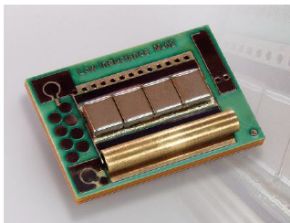
Figure 3: Assembled module with 570 pH DC link inductance (E. Hoene, Fraunhofer IZM)
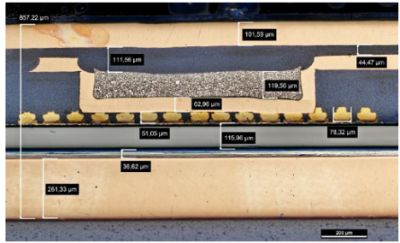 Zoom Picture
Zoom Picture
Figure 4: Cross section of module with capacitors and a current sensor
Prof. Dushan Boroyevich/ CPES, Virginia Tech, described recent developments regarding active filters to suppress conducted EMI signals. One of his conclusions is that current advancements in systematic EMI mitigation techniques and design procedures are turning the EMI filter design and integration from “art” into “science”.
Dr. Reinhold Bayerer/ Infineon presented “Transient hygro-thermal-response of power modules in inverters-mission profiling for climate and power loading”. This topic becomes more and more important because the number of outdoor applications increases, like in wind and solar energy. The moisture profiles can be gained by using a hygro-thermal equivalent circuit containing controlled capacitors and resistors. Condensation of water can be covered by controlled Zener diodes or active circuitry.
Dave Saums presented a comprehensive description on “Practical aspects of testing methods for thermal interface materials”. He outlined differences in principal testing procedures and how generally to interpret and make use of the data, especially in comparison to vendor-provided data.
As in the previous CIPS conference there were two awards:
The VDE Best Poster Award of 1000 € in recognition of an outstanding paper presented in the dialogue session. The award committee selected “Impact of the control on the size of the output capacitor in the integration of Buck converters”, presented by Jorge Cortes, Universidad Politecnica de Madrid.
The ECPE Young Engineers Award promoting young engineers presenting papers at CIPS. The award of 1000 € was split between two winners:
- Bianca Böttge et al/ Fraunhofer IWM for “High resolution failure analysis of silver-sintered contact interfaces for power electronics”, and
- Christian R. Müller et al/ Infineon for “Low-inductive inverter concept by 200A/1200V half bridge in EasyPack 2B – following strip-line design” (Figure 5).
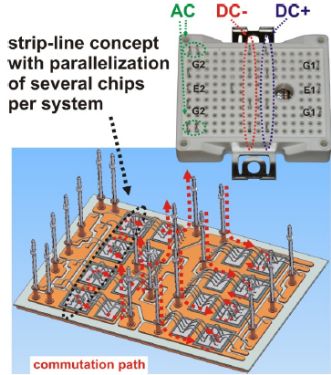 Zoom Picture
Zoom Picture
Figure 5: Infineons low-inductive inverter concept in an EasyPack 2B (C. Müller, Infineon)
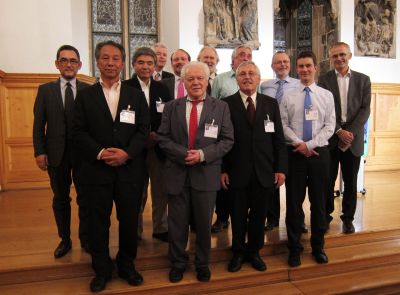 Zoom Picture
Zoom Picture
Figure 6: At the Conference Dinner in the Historica City Hall Nurembg. From left:
Dr. Kimimori Hamada, Toyota Motor Corp, Steering Committee Member; Prof. Daisuke Ueda, Panasonic, Keynote speaker; Prof. Hiromiche Ohashi, AIST, Steering Committee Member; Prof. Cian O`Mathuna, Tyndall National Institute, Invited Speaker; Thomas Harder, ECPE; Prof. Dieter Silber, Universität Bremen, Technical Chair; Prof. Dushan Boroyewich, CPES / Virginia Tech, Invited Speaker; Prof. Josef Lutz, Universität Chemnitz, Invited Speaker; Prof. Eckhard Wolfgang, ECPE, Technical Program Chair; Dr. Reinhold Bayerer / Infineon / Invited Speaker; Dr. Eckart Hoene, Fraunhofer IZM, Invited Speaker; Prof. Frede Blaabjerg, Aalborg University, Invited Speaker.